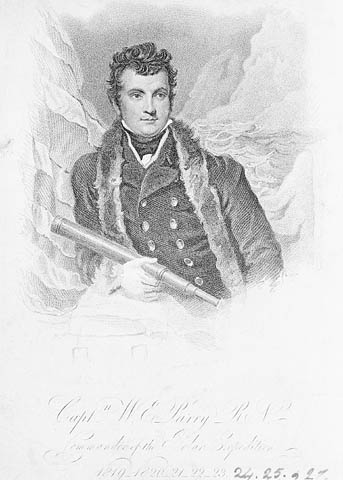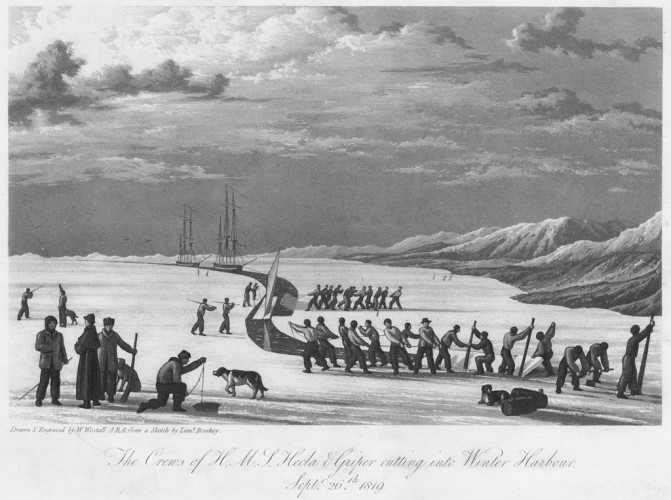<Back to Index>
- Explorer William Edward Parry, 1790
- Novelist Jean Genet, 1910
- President of the Republic of Poland (4th in Exile) Edward Bernard Raczyński, 1891
PAGE SPONSOR


Sir William Edward Parry (19 December 1790 – 8 or 9 July 1855) was an English rear-admiral and Arctic explorer, who in 1827 attempted one of the earliest expeditions to the North Pole. He reached 82°45′ North latitude, setting the record for human exploration farthest North that stood for nearly five decades before being surpassed at 83°20′26″ by Albert Hastings Markham in 1875 - 1876.
Parry was born in Bath, the son of Dr. Caleb Hillier Parry and Sarah Rigby. He was educated at King Edward's School, Bath. At the age of thirteen he joined the flagship of Admiral Cornwallis in the Channel fleet as a first class volunteer, in 1806 became a midshipman, and in 1810 received promotion to the rank of lieutenant in the frigate Alexander, which spent the next three years in the protection of the Spitsbergen whale fishery. He took advantage of this opportunity for the study and practice of astronomical observations in northern latitudes, and afterwards published the results of his studies in a small volume on Nautical Astronomy by Night (1816). From 1813 - 1817 he served on the North American station.
In 1818 he received command of the brig Alexander in the Arctic expedition under Captain (afterwards Sir) John Ross. This expedition returned to England without having made any new discoveries but Parry, confident, as he expressed it, "that attempts at Polar discovery had been hitherto relinquished just at a time when there was the greatest chance of succeeding", in the following year obtained the chief command of a new Arctic expedition; consisting of the two ships HMS Griper and HMS Hecla.
This expedition returned to England in November, 1820 after a voyage of almost unprecedented Arctic success, having accomplished more than half the journey from Greenland to Bering Strait, the completion of which solved the ancient problem of a Northwest Passage. A narrative of the expedition, entitled Journal of a Voyage to discover a North-west Passage, appeared in 1821.
Upon his return Lieutenant Parry received promotion to the rank of commander. In May 1821 he set sail with the HMS Fury and HMS Hecla on a second expedition to discover a Northwest Passage, but had to return to England in October 1823 without achieving his purpose. During his absence he had in November 1821 been promoted to post rank, and shortly after his return he was appointed acting hydrographer to the navy. His Journal of a Second Voyage, &c., appeared in 1824.
With the same ships Parry undertook a third expedition on the same quest in 1824, but again unsuccessfully, and following the wreck of the Fury, he returned home in October 1825 with a double ship's company. He published an account of this voyage in 1826.
He was
elected a Fellow of the
Royal Society in
February 1821. In the
following year Parry obtained the sanction of the Admiralty for an attempt on the North Pole from the northern shores of Spitsbergen at Seven Islands.
On 23 October 1826 Parry married Isabella Louisa Stanley, daughter of John Stanley,
1st Baron Stanley of Alderley
and Lady Maria
Josepha Holroyde before
undertaking the expedition. In 1827
he reached 82°45’N,
which remained for 49 years the highest latitude attained. He published
an account of this journey under the title of Narrative of the Attempt
to reach the North Pole, &c. (1827). In April
1829 he was knighted. Parry served as Commissioner of the Australian
Agricultural Company based
at Tahlee on the northern shore of Port Stephens New South Wales, Australia from 1829 to 1834. Parry
was subsequently selected for the post of comptroller of the
newly-created department of steam machinery of the Navy, and held this
office until his retirement from active service in 1846, when he was
appointed captain superintendent of Haslar Hospital.
He reorganised the Packet Service (overseas
mail), which had been transferred from the Post Office to the Admiralty
in January 1837. Steamship companies were contracted to carry the mail,
instead of naval vessels, on a regular schedule. He
attained the rank of rear-admiral in 1852, and in the following year
became a governor of Greenwich
Hospital, and retained this post until his death. Sir
William Parry’s character was influenced by his unwavering belief in
Jesus Christ, and besides the journals of his different voyages he also
wrote a Lecture to
Seamen, and Thoughts on the Parental Character of God. He was noted
as "an evangelical [Christian] and an ardent advocate of moral reform
in the navy." Parry
also pioneered the use of canning techniques for food
preservation on
his Arctic voyages. However, his techniques were not infallible: in
1939 viable spores of certain heat resistant bacteria were found in canned roast
veal that had traveled with Parry to the Arctic Circle in 1824. The crater Parry on the Moon was named after him, as was Parry County,
New South Wales, Parry Sound,
Ontario, Canada, and the optical phenomenon Parry arc,
documented by him during the 1819 - 1821 expedition.